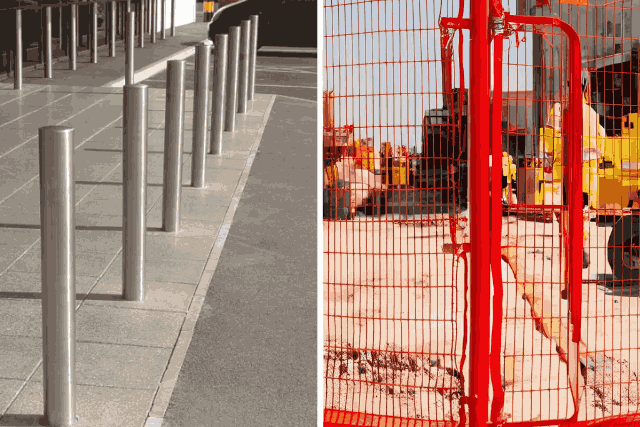
When it comes to ensuring safety, managing traffic, or protecting infrastructure, bollards and barriers are two of the most commonly used solutions. While they might seem similar in purpose, they serve distinct roles based on functionality, cost, and ease of installation. In this article, we’ll explore these key differences to help you make the right choice for your project.
1. Purpose: What Do You Need to Protect?
Bollards: Compact and Versatile
Bollards are sturdy posts made from steel, concrete, or other strong materials. They allow people to move freely while blocking vehicles. They work well in places where security and accessibility must go hand in hand.
Where Bollards Are Used:
- Pedestrian Safety: Placed near sidewalks, storefronts, and bike lanes to stop cars from entering.
- Traffic Control: Used to create pathways and prevent illegal parking.
- High-Security Areas: Anti-ram bollards protect important buildings.
- Aesthetic Appeal: Decorative designs add safety without looking out of place.
Why Choose Bollards?
- Space-saving design
- Lets pedestrians pass through
- Works in many locations
However, bollards may not be the best choice for blocking large areas or for temporary use.
Barriers: Stronger and More Protective
Barriers are bigger structures—such as concrete blocks, metal barricades, or fences—designed to create clear boundaries and stop vehicle access completely. They are ideal for protecting large areas or controlling access temporarily.
Where Barriers Are Used:
- Event Management: Helps control crowds and vehicles at concerts and sports events.
- Construction Sites: Blocks people from entering dangerous areas.
- Vehicle Restriction: Heavy-duty barriers stop unauthorized vehicles.
- Emergency Use: Quickly placed to close roads in urgent situations.
Why Choose Barriers?
✔ Covers large areas
✔ Can be permanent or temporary
✔ Easy to deploy in emergencies
However, barriers can be bulky, less visually appealing, and may block pedestrian paths if not placed carefully.
2. Cost: Which One is More Budget-Friendly?
Bollards: A Long-Term Investment
Bollards usually cost more upfront, especially advanced types like retractable or automatic bollards. However, they require little maintenance and last for years.
What Affects Bollard Costs?
- Material: Stainless steel, concrete, or reinforced plastic affect the price.
- Type: Retractable and removable bollards are pricier than fixed ones.
- Installation: Permanent bollards need professional installation with a strong foundation.
Why Bollards Are Worth It:
- Long-lasting with little maintenance
- Offers both function and design
- Great for public and commercial spaces
Barriers: Lower Initial Cost, More Flexibility
Barriers, especially temporary ones, are more affordable at the start. However, they may need frequent maintenance or replacement, especially if they are exposed to harsh weather or heavy impact.
What Affects Barrier Costs?
- Material: Steel, plastic, or concrete have different price points.
- Temporary vs. Permanent: Portable barriers are cheaper but wear out faster.
- Maintenance: Painting, repositioning, or replacing damaged barriers adds to long-term costs.
Why Barriers Can Be Cost-Effective:
- Cheaper upfront for short-term needs
- Can be moved and reused
- Ideal for temporary or large projects
3. Installation: Which One is Easier to Set Up?
Bollards: Sturdy but Time-Consuming
Installing bollards depends on the type:
- Fixed Bollards: Require digging and a concrete foundation for stability.
- Retractable Bollards: Take longer to install but offer flexible access control.
- Surface-Mounted Bollards: Easier to set up but less sturdy.
Although installation takes effort, the result is a strong and reliable security solution.
Best For: Permanent security, pedestrian areas, and places that need both safety and design.
Barriers: Fast and Easy to Deploy
Barriers—especially temporary ones—are much simpler to install:
- Temporary Barriers: Set up in minutes with minimal effort.
- Permanent Barriers: Need a foundation but are easier to install than fixed bollards.
While permanent barriers provide long-term protection, portable barriers are great for short-term use or emergencies.
Best For: Temporary events, construction zones, and emergency situations.
Final Thoughts: Which One Should You Choose?
- Choose Bollards if you need a space-saving, long-term security solution that allows pedestrian movement.
- Choose Barriers if you need broad coverage, quick setup, or temporary protection.
Both options improve safety, but the right choice depends on your needs. Whether securing a public space, managing event traffic, or blocking unauthorized access, picking the right solution ensures better protection and smoother traffic flow.
Contact Us